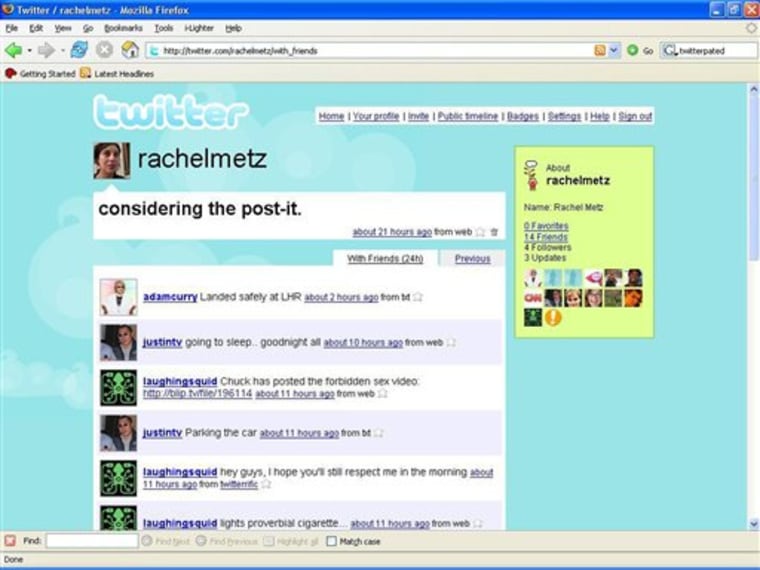Until a few weeks ago, I thought I was well-connected. I text message and IM friends at a dizzying pace. I keep up with four social-networking sites daily, check e-mail obsessively and even blog when the mood hits me.
But then, around the beginning of April, I started using Twitter — and realized I'm just a neophyte in the fraternal order of constant communication.
Twitter is meant for keeping tabs on friends, who can post notes on what they're up to for you to receive on its Web site, a cell phone or through instant messages. I post messages, too, so they can keep up with me. I can add several friends, even strangers, to my circle, and others can do the same unless I restrict my updates to friends only.
Launched in July by San Francisco-based Obvious Corp., the service is free and has even spawned some cool mash-ups, like the mesmerizing and sometimes nauseating Twittervision.com, which zooms across a world map to show where updates are coming from.
If you're under 20, Twitter's mission might leave you, well, twitterpated — a bit excited, that is. Facebook and Friendster have features for easily tracking friends' activities on the site, but neither provides as many possibilities for constant interaction as Twitter.
With Twitter, updates can come at you constantly, and they're often more mundane — "meetings suck!" and "at work, avoiding work," to give you a flavor — than the average personalized IM or text message.
The site itself sports a bubble-lettered logo and is splashed with a cheery aqua hue. The home page features constant updates on users you don't know, giving newcomers a good sneak peek at the service. Setting up an account is simple, and the site is easy to navigate and use.
Based on its interface and ease of use, my inner teenager thought Twitter sounded pretty fun.
At the same time, my outer adult worried of being bombarded with the minutiae of my office-bound friends' lives — much of which I'm already aware through the aforementioned instant messaging. I was also concerned I wouldn't be doing enough interesting things to warrant blasting my activities to a list of buddies.
But I gave it a try. For about two weeks, I got my Twitter on. I made posts, added friends and kept an eye on the incoming stream.
At first, the experience was pretty benign. I updated as often as I remembered, almost every day, and sometimes several times a day. My missives weren't earth-shattering (example: "drinking coffee and diet pepsi at the same time ... supposedly this will wake me up."), but it was kind of fun trying to make short, snappy posts.
During the first day, things were going smoothly, so I opted to receive updates on my cell phone.
Twitter lets you turn updates off during certain hours, but I stupidly figured nobody would bother sending a message at, say, 6:30 a.m. on a Saturday.
How wrong I was. At first, the incoming texts were just clogging my cell phone's text inbox. But then, in the early hours of a recent Saturday, I awoke to the unmistakable buzz of an incoming text message.
It was from Justin Kan of Justin.tv, which lets viewers watch Kan's life 24 hours a day via a webcam he wears on his head. The message read simply, "sleeeeeeep."
I rolled my eyes and texted, "Being woken up by incoming twitter txts" back to the site.
Near the end of my experiment I switched the messages from the phone to AOL's instant-messaging service. After about two hours of random messages popping up on my screen, I was ready to cut Twitter off.
Though these were issues I could — and did — solve on my own, there were others beyond my control. Most notably is the lack of a search feature, which means users have to invite new people to sign up or stumble upon friends to add them. This made it hard to find those I knew, and I ended up clicking around on random members' pages to find people of interest.
Twitter co-founder Jack Dorsey told me that recent traffic growth led Twitter to cut off its search feature to keep the site from crashing. He said the number of users and messages have been doubling every three weeks over the past three months, though he wouldn't provide specific totals.
Despite my gripes, I did have some fun with Twitter. I enjoyed reading a co-worker's condensed rants about Starbucks' coffee sizes ("i really don't think starbucks should force me to use words like 'grande' and 'venti.' they pretend to be all confused when i say medium") and woke up to a friend's note on Easter reading simply, "BUNNY DAY."
The site also had some news and retail-oriented users I liked keeping up with, including Woot.com, which broadcasts deals on electronics and sends alerts when items sell out. I tend to forget to check its Web site, so befriending its Twitter presence served as a useful reminder.
In the end, though, Twitter was just too much communication for me. The company plans a digest feature for sending compiled updates every so often, the way you can get messages on some mailing lists in batches.
That might sway those like me who are interested but don't want all Twitter, all the time. But in the meantime, I'll stick with my other five means of keeping in touch.
